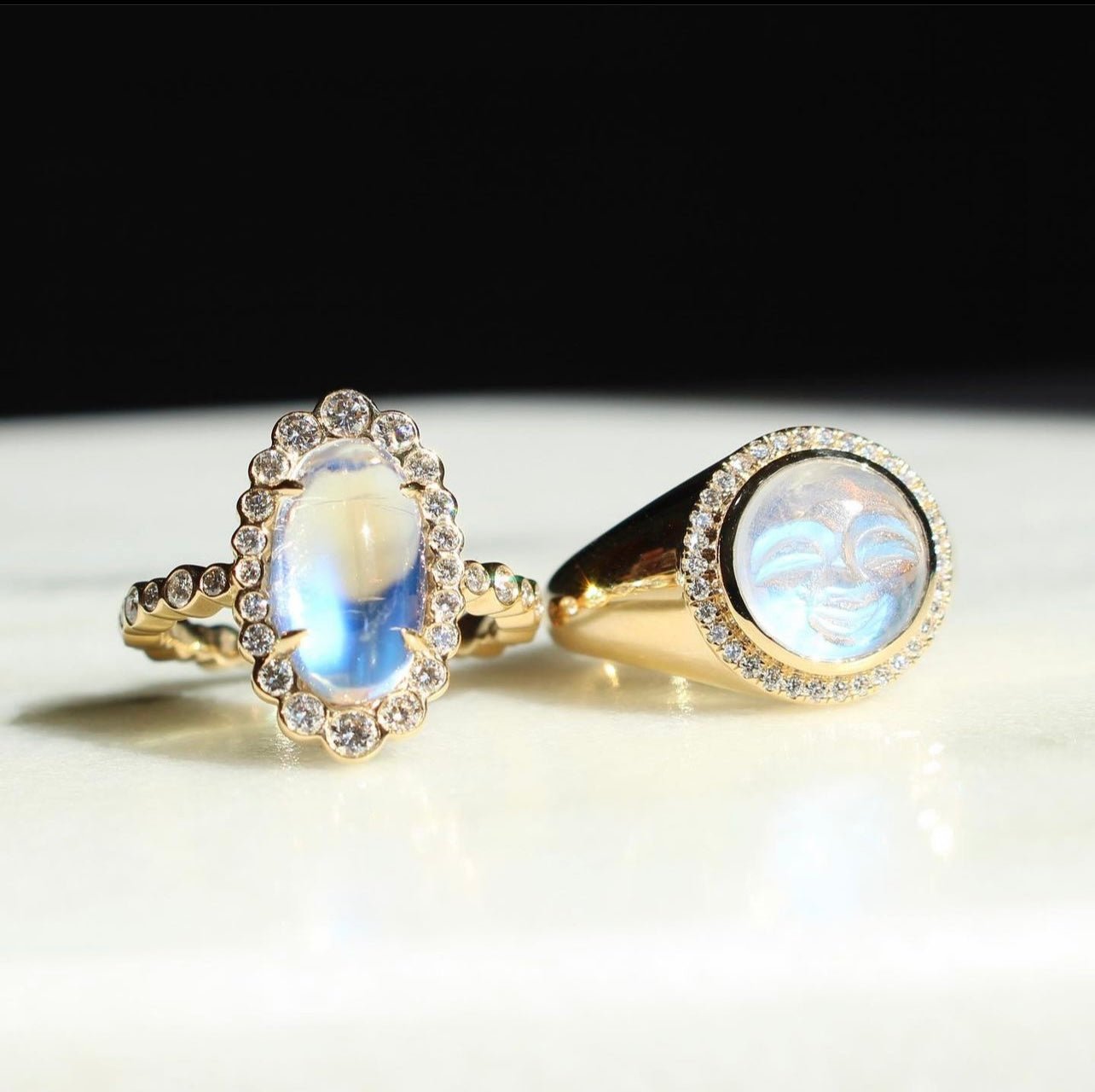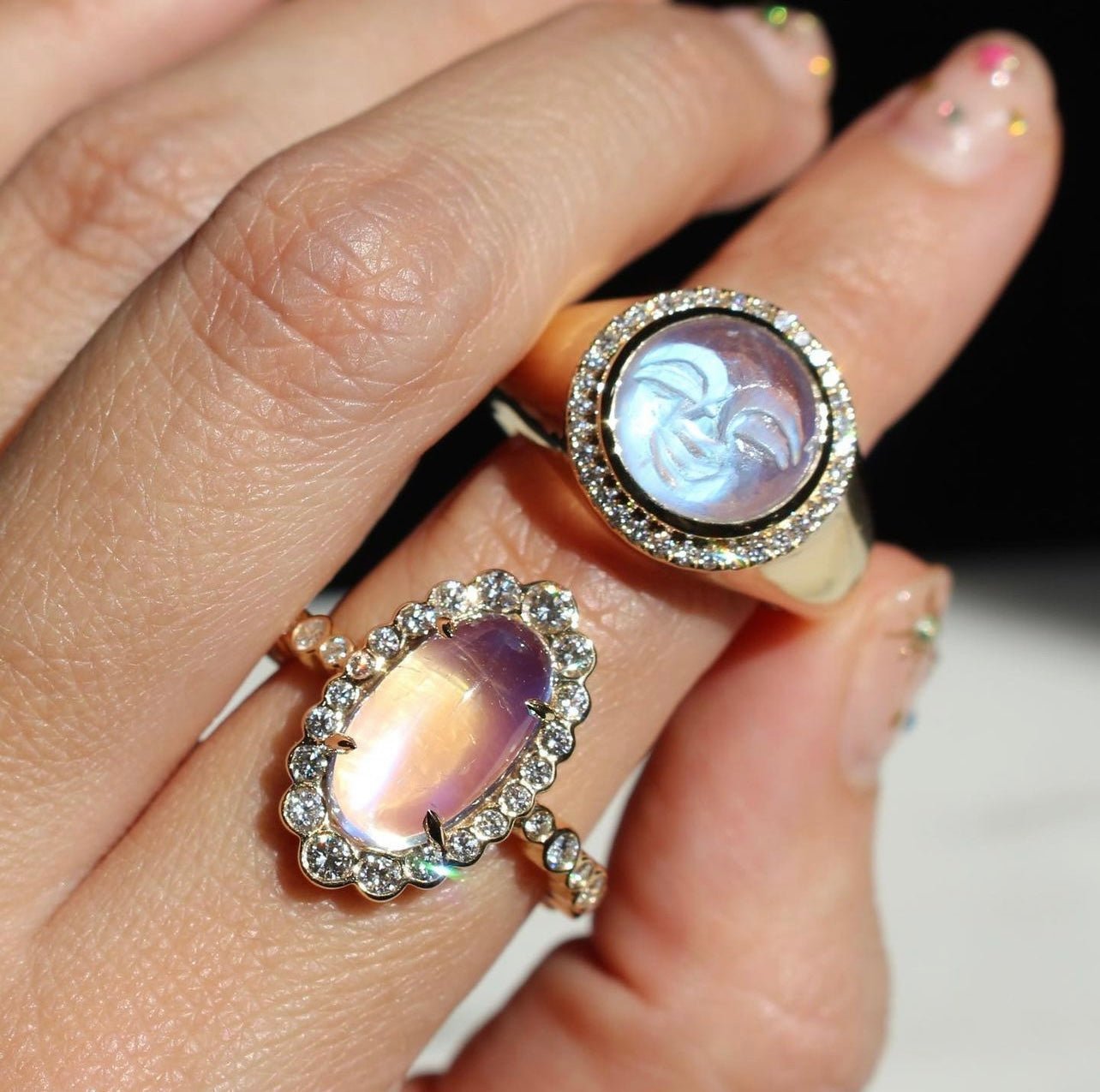When comparing gemstones, it’s important to always remember that their beauty is in the eye of their beholder.
What one customer loves about a gem, another might hate. This is especially true when it comes to colored gemstones because they vary so greatly. However, the core values of gem grades (color, clarity, cut, and carat weight) apply universally.
When we look at alexandrite and amethysts, the two stones might appear similar on the surface. To the naked eye, both have gorgeous purple-red hues. Yet alexandrite is far rarer and more multifaceted than amethyst —which is the rarest quartz.
We’re not just saying that because we have a soft spot for exotic gemstones. We mention it because alexandrite is able to transition from mesmerizing greens to beautiful reds under different lighting.
Apart from this obvious difference between the two gemstones, they do have some similarities. Let’s dive into what sets them apart in the world of warm-toned gemstones. That way, you can make the most educated purchase possible.
How Was Alexandrite Discovered?
If you know Mark Henry Jewelry, you probably know this story all too well. It never gets old, so allow us to jog your memory. In the 1830s, the famed mineralogist Nils Gustaf Nordenskiöld was leading an expedition through Russia’s Ural Mountains.
Nordenskiöld’s team was lucky enough to stumble upon a piece of alexandrite in their search, and the gem world changed forever. At first, everyone thought that they had found a particularly quality emerald. The Ural Mountains were known to carry these gems in abundance.
However, when the gemstone was placed underneath incandescent lighting, it quickly transformed into a breathtaking red hue.
What could it be?
Careful consideration and examination allowed gemologists and mineralogists alike to agree they had stumbled upon a brand new stone. They named it “alexandrite” after the ruler of Russia at the time.
How Was Amethyst Discovered?
As far as the discovery of amethyst goes, their story is far less clear.
Amethysts were beloved by the Ancient Greeks and have been in circulation for many purposes for tens of thousands of years. While their origin may not be concrete, they have certainly earned their place in history.
Historical Significance
Alexandrites are inextricably tied to Czar Alexander II (their namesake) and the Russian Royal Family. At the time of their finding, the monarchy was the top trendsetter.
The Royal’s Family incorporation of alexandrite into jewelry and royal regalia made it world-renowned. It also forced the Ural Mountain mines to run out of stones very quickly, forcing an international search for new sources.
As we stated before, the Ancient Egyptians and Ancient Greeks were fond of amethysts and used them often for protection.
The stones were named after the Greek word amethystos, which means “not drunk.” The myth of Bacchus and the Amethyst states that the power of the gemstone could sober up even the Roman god of wine himself. The tale was also captured in a 1576 poem by Remy Belleau (“Amethyst or the loves of Bacchus and Amethyste”), perpetuating this amethyst myth.
Where Is Alexandrite Found?
Alexandrite is most prized when it comes from the original Russian supply, but it is only sold as an antique from this region.
Brazilian alexandrite is the closest that you can get to emulating Russian alexandrite. This supply was discovered in the 1980s and quickly became the primary resource for most high-end jewelers.
Since then, alexandrite has been discovered and mined in Sri Lanka, Zimbabwe, and parts of Africa.
Where Is Amethyst Found?
Amethysts are most prized when mined in Siberia. Siberian amethysts are the most highly saturated purples. In fact, Siberian amethysts are so popular that they have become their own category of amethyst. They are used to label any intensely purple, high-quality amethyst.
To date, amethysts have been found in Brazil, Canada, Bolivia, Uruguay, South Korea, Brazil, and more. It is even found in the United States on occasion, with known mines in Texas, Arizona, Georgia, Wisconsin, North Carolina, Michigan, Maine, and Minnesota.
It is clear just in this comparison alone that amethysts are rarer than alexandrites.
How Do Alexandrite and Amethyst Compare?
In order to explain how alexandrites and amethysts differ, we must explore their physical properties.
Composition
Alexandrite is a type of chrysoberyl. It is made up of beryllium and chromium. The reason why it is so incredibly rare is that these two elements are not often found in the same rock. You can find alexandrites in a few different rock formations: gneiss, mica schist, pegmatites, and dolomitic marbles.
They have a vitreous luster and a specific gravity that is between 3.68 and 3.80. They do have fluorescent, UV-long, and UV-short luminescence. Alexandrites are sensitive to heat as well.
Amethysts are a type of quartz, which puts them in an entirely different crystalline mineral family. The crystals that create amethyst come from volcanic lava, and the gemstone itself is silicon dioxide. It can be found in alluvial deposits but mostly in pegmatites, just like alexandrite.
Amethysts also have a vitreous luster with a specific gravity of 2.651. They have fluorescent and UV-short luminescence like alexandrite but do not have a UV-long luminescence. Instead of heat sensitivity, they actually undergo heat treatments to improve their appearance.
Durability
Alexandrites are more durable than amethysts, but not by much.
On the Mohs hardness scale, alexandrites fall between 8 and 8.5, while amethysts are 7. The latter gem is only slightly softer than the former, but this can make a difference in wearability when they’re placed in easily scratched pieces (rings, bracelets, etc.).
Color
This is where the gemstones are clearly set apart: color.
As we mentioned earlier, alexandrites are pleochroic. They are famed for their ability to instantly go from green in daylight to red when the sun sets. Since they are transitional stones, they do come in a wide variety of these two hues. Some examples can include blue-green daylight stones and red to incandescent violet stones.
Amethysts are far more structured in their purple-like coloring. They can have bright or duller versions of purple to lilac, but the only other hue they might look like is pink/red. They are strictly warm-toned.
Size
Other physical variants between the two stones include their sizes. Most amethysts are less than 100 carats, and highly sought-after transparent ones are even smaller.
Alexandrites are incredibly small in comparison, usually coming in as less than one carat. The Smithsonian owns the biggest known piece of alexandrite, which is only 65.7 carats.
Price Differences
Since alexandrites are rarer than amethysts, they naturally cost more.
These gems can be upwards of $15,000 per carat, which is not as expensive as it may seem when you consider that they are rarely that big. $40,000 is a more typical expectation for alexandrites that weigh more than one carat.
In comparison, amethysts are wildly affordable.
On the higher end, even transparent, bright stones are about $40 a carat. While this can seem attractive to those on a budget, remember that you get what you pay for.
It may be worth it to purchase an amethyst as you begin to build a gemstone collection. Later, you can transition to a pricier alexandrite once you decide what style you want to invest in.
How Common Are Fake Amethyst and Alexandrite?
There are plenty of fake amethysts and alexandrites out there. These are often made from two specific materials — synthetic corundum and synthetic spinel.
Synthetic corundum and synthetic spinel are alexandrite dupes that might be able to fool unsuspecting shoppers.
If you look closely, synthetic corundum tends to stray further from the green-to-red transition of the real stone. It may appear to move from a grayer blue to a reddish purple. It is best to get a jeweler on board when identifying synthetic gemstones. Natural alexandrite has a refractive index of 1.755, but synthetic corundum’s refractive index is between 1.762 and 1.770.
Amethysts are not as commonly imitated because they are not as rare as alexandrites, so the demand is not as high. However, when needed, smoky quartz is fed gamma rays to make these fake stones. Since amethysts are affordable, it is best to stay away from their imitations — they are not worth it.
The Folklore and Symbolism of Amethyst and Alexandrite
The one downside to alexandrite is that it does not have as rich folklore as amethyst does. This is because it is a much younger stone, only discovered about two centuries ago. It has not had time to weave its way through as many cultures.
Amethyst is an ancient gemstone, and its symbolism reflects that. Those who believe in crystal healing adore amethyst for its supposed effects that are said to boost health. It is commonly seen in protective amulets.
Both alexandrites and amethysts are birthstones, though! Alexandrite is the birthstone for June alongside the pearl, and amethysts are the birthstone for February. This makes either stone an excellent gift for anyone celebrating an appropriately-timed special day.
Eye of the Beholder
While alexandrite is the obvious choice for a fine gem lover, amethysts are a wonderful alternative. They are another warm-toned gemstone that can do the trick in jewelry pieces. Consider your investment approach when shopping.
Sources:
Alexandrite Value, Price, and Jewelry Information | International Gem Society
Amethyst Value, Price, and Jewelry Information | International Gem Society
Amethyst Symbolism and Legends | International Gem Society
Biography of Alexander II, Russia's Reformist Tsar | ThoughtCo

